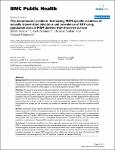The denominator problem: Estimating MSM-specific incidence of sexually transmitted infections and prevalence of HIV using population sizes of MSM derived from Internet surveys
Marcus, Ulrich
Schmidt, Axel J.
Kollan, Christian
Hamouda, Osamah
Background: Measuring prevalence and incidence of sexually transmitted infections in hard to reach populations like men who have sex with men (MSM) is hampered by unknown size and regional distribution of this population. Community sample – and study-based measurements are often fraught with participation biases and do not allow generalization of the results for other regions or the whole population group of MSM. Methods: We used the proportional regional distribution of participants of large internet-based surveys among MSM from Germany together with a general population survey-derived estimate of the MSM population to estimate regional population sizes. Based on transmission group category from surveillance data and regional MSM population size we calculated regional population-specific incidence rates of newly diagnosed HIV infection and syphilis. For HIV prevalence we compared estimates of prevalent HIV infections in MSM from a surveillance databased model with a mixed model in which we used the proportional regional distribution of HIV positive participants from surveys and the estimated total number of prevalent HIV infections from the surveillance based model. Results: Assuming a similar regional distribution of survey participants and the MSM population as a whole, the regional proportion of MSM in the general population can be estimated. Regional incidence calculated with the estimated MSM population as denominator and national surveillance data as numerator results in regional peak incidence rates of 7–8 per 1,000 MSM for newly diagnosed HIV infection and syphilis. The gradient between metropolitan and rural areas narrows considerably compared with calculations which use the total (male) population as denominator. Regional HIV prevalence estimates are comparable in the two models. Conclusion: Considering the difficulties to obtain regionally representative data by other sampling methods for MSM, in Western post-industrialized countries internet-based surveys may provide an easy and low cost tool to estimate regional population distributions. With national surveillance data, which categorize transmission groups, regional population-specific incidence rates for reportable sexually transmitted infections can be estimated. HIV prevalence estimates for regional MSM populations show differences related to the level of urbanization, MSM concentration, and starting points of the HIV epidemic in western and eastern Germany.
No license information

